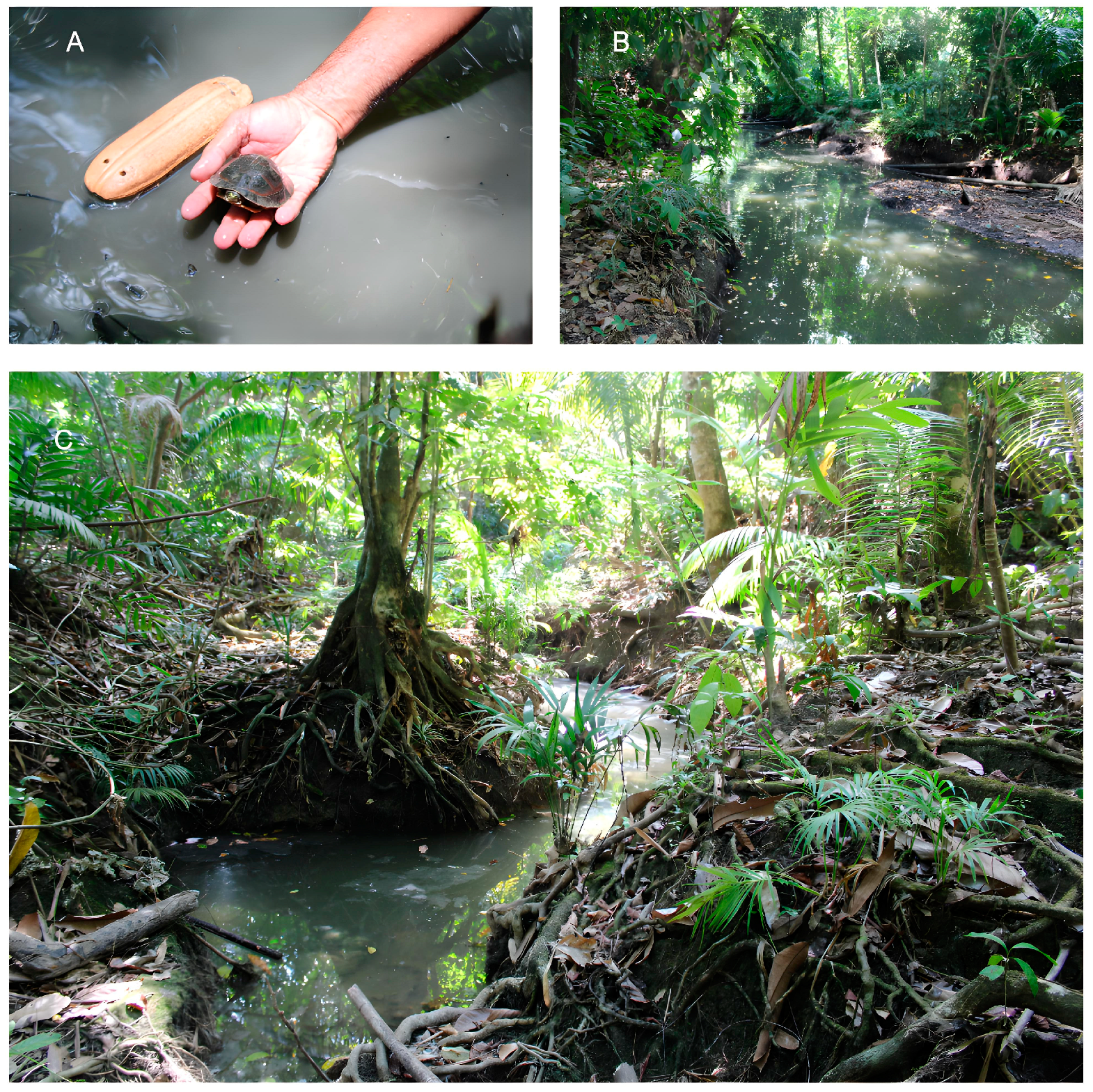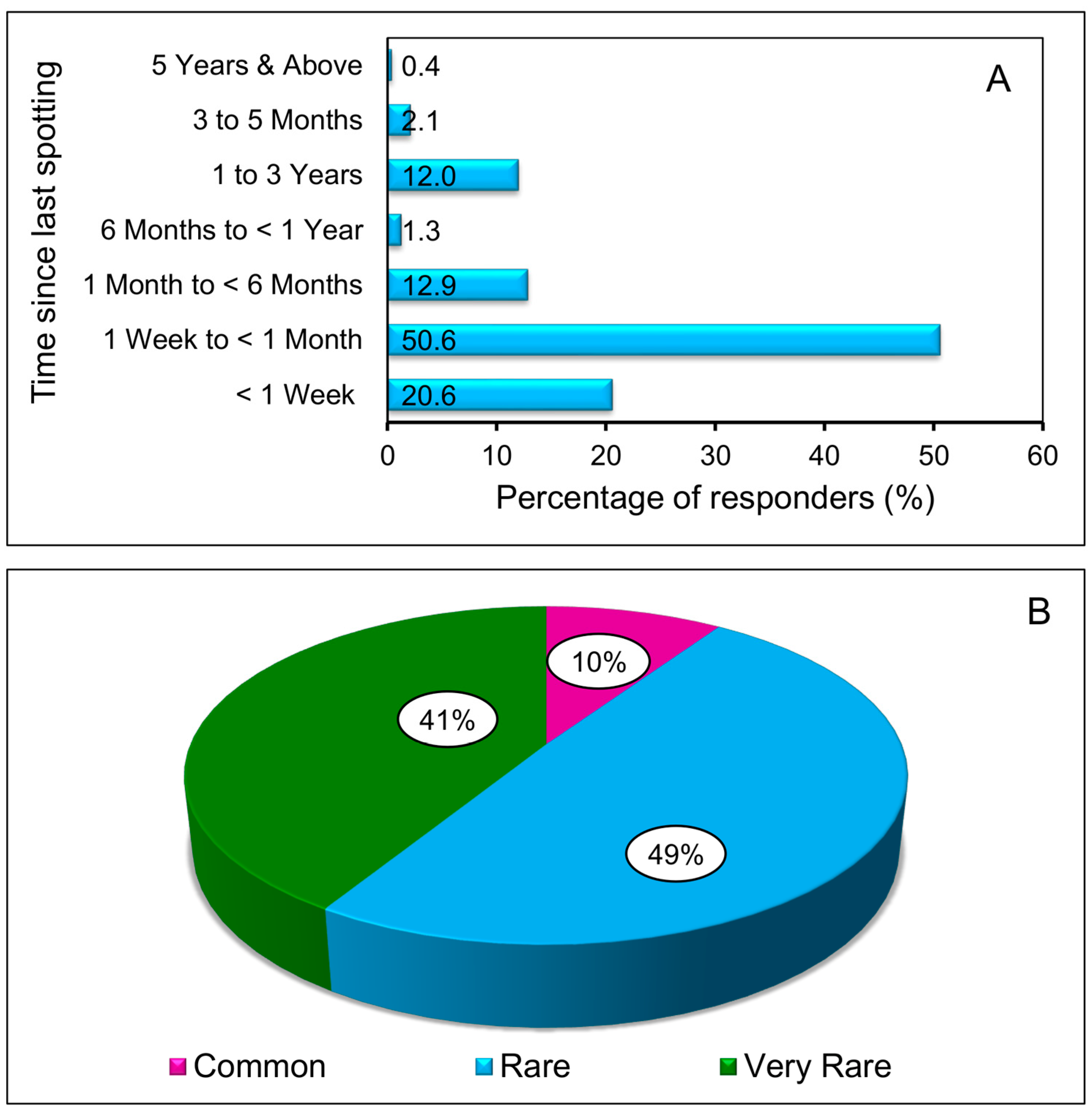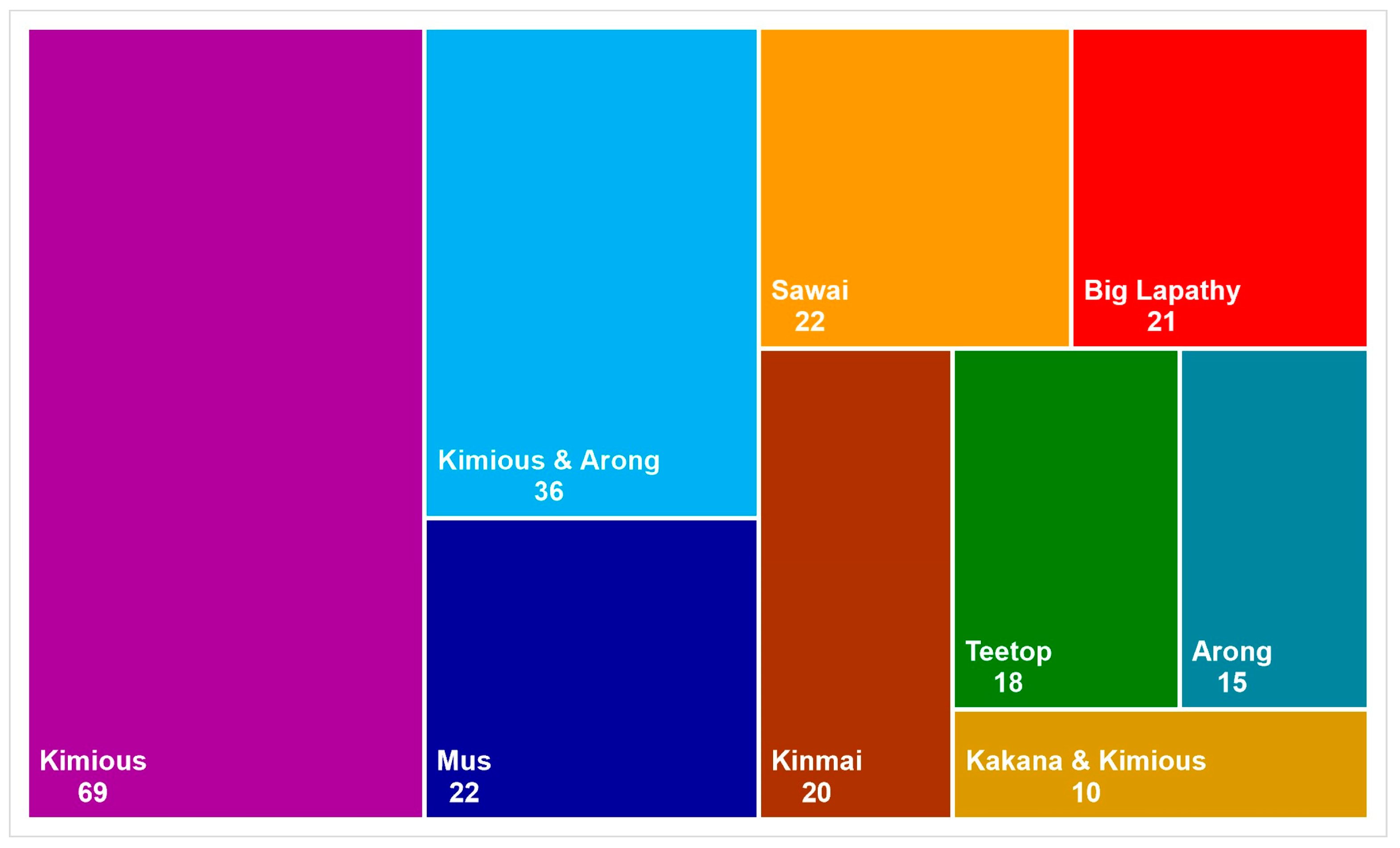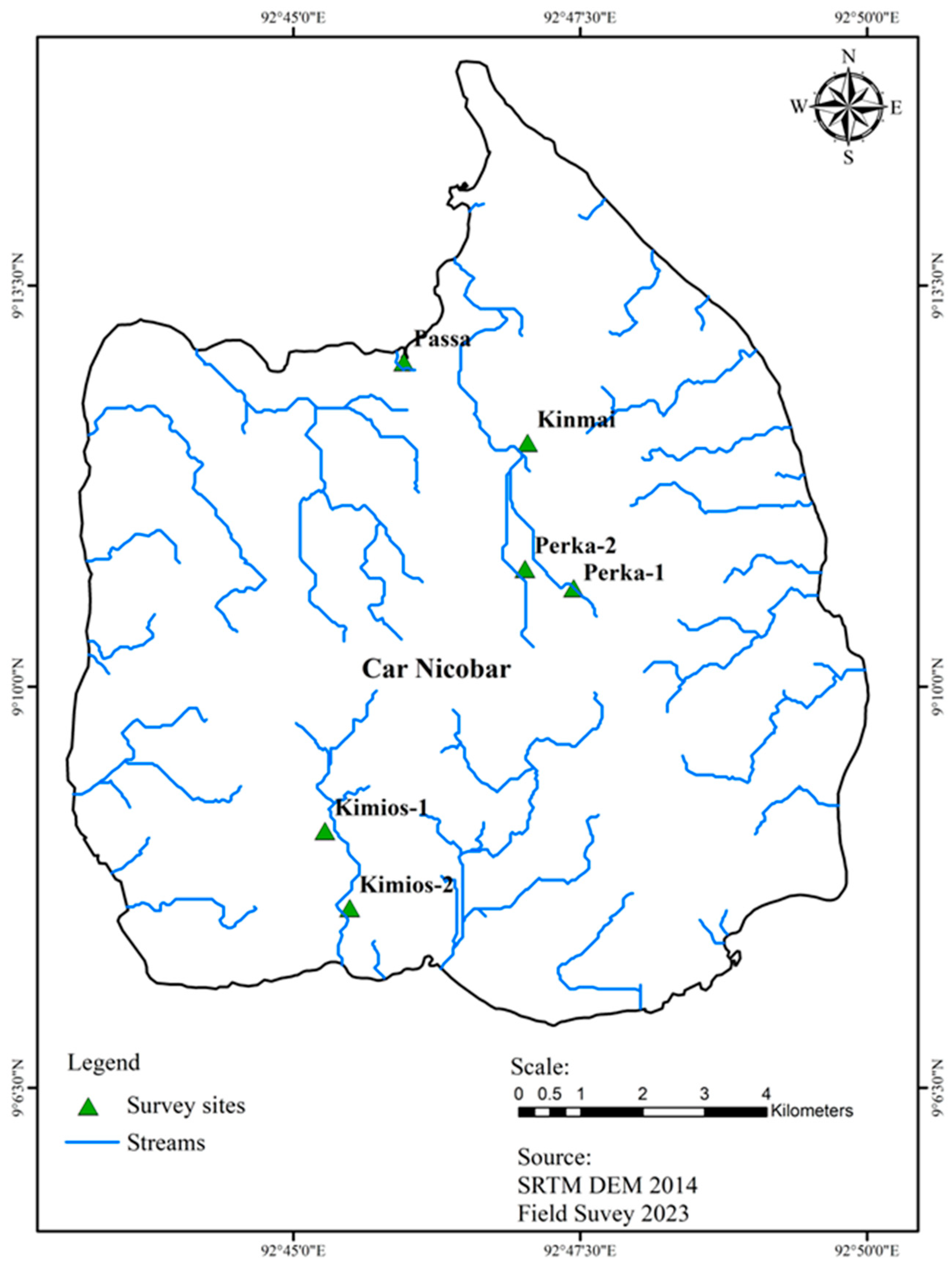Aboriginal Tribe’s Knowledge of the Endangered Freshwater Turtle Cuora amboinensis in Car Nicobar, a Remote Oceanic Island in the Bay of Bengal
Abstract
1. Introduction
2. Materials and Methods
2.1. Field Sampling of C. amboinensis Individuals
2.2. Stakeholder Surveys
2.3. Mapping and Statistical Analysis
3. Results
3.1. Species Identification
3.2. Stakeholder Response
3.3. Known Habitats of Box Turtle
3.4. Stream Network Map
3.5. Garrett’s Ranking of Future Conservation
4. Discussion
5. Conclusions
Supplementary Materials
Author Contributions
Funding
Institutional Review Board Statement
Informed Consent Statement
Data Availability Statement
Acknowledgments
Conflicts of Interest
References
- Stanford, C.B.; Iverson, J.B.; Rhodin, A.G.; van Dijk, P.P.; Mittermeier, R.A.; Kuchling, G.; Berry, K.H.; Bertolero, A.; Bjorndal, K.A.; Blanck, T.E.; et al. Turtles and tortoises are in trouble. Curr. Biol. 2020, 30, R721–R735. [Google Scholar] [PubMed]
- Rhodin, A.G.J.; Van Dijk, P.P.; Parham, J.F. Turtles of the world: Annotated checklist of taxonomy and synonymy. Chelonian Res. Monogr. 2008, 5, 38. [Google Scholar]
- Eastman, C.B.; Farell, J.A.; Whitmore, L.; Ramia, D.R.R.; Thomas, R.S.; Prine, J.; Eastman, S.F.; Osborne, T.Z.; Martindale, M.Q.; Duffy, D.J. Plastic ingestion in post-hatchling sea turtles: Assessing a major threat in Florida near shore waters. Front. Mar. Sci. 2020, 7, 693. [Google Scholar] [CrossRef]
- Ernst, C.H.; Arndt, F.L.; Jeffrey, E.L. A morphological review of subspecies of the Asian box turtle, Cuora amboinensis (Testudines, Geomydidae). Proc. Biol. Soc. Wash. 2016, 129, 144–156. [Google Scholar] [CrossRef]
- Cota, M.; Hoang, H.; Horne, B.D.; Kusrini, M.D.; Mc Cormack, T.; Platt, K.; Schoppe, S.; Shepherd, C. Cuora amboinensis. The IUCN Red List of Threatened Species 2020, e.T5958A3078812. Available online: https://www.iucnredlist.org/species/5958/3078812 (accessed on 1 August 2023).
- Bhupathy, S.; Choudhury, B.C. Turtle Fauna of Arunachal Pradesh; Preliminary Report; Wildlife Institute of India: Dehra Dun, India, 1992; p. 15. [Google Scholar]
- Schoppe, S.; Das, I. Cuora amboinensis (Riche in Daudin 1801)—Southeast Asian Box Turtle. In Conservation Biology of Freshwater Turtles and Tortoises; Chelonian Research Monographs; Chelonian Research Foundation: Lunenburg, MA, USA, 2011; Volume 1, pp. 053.1–053.13. [Google Scholar]
- Stanford, C.B.; Rhodin, A.G.J.; van Dijk, P.P.; Horne, B.D.; Blanck, T.; Goode, E.V.; Hudson, R.; Mittermeier, R.A.; Currylow, A.; Eisemberg, C.; et al. Turtles in Trouble: The World’s 25+ Most Endangered Tortoises and Freshwater Turtles. Turtle Conservation Coalition 2018, p. 80. Available online: https://portals.iucn.org/library/sites/library/files/documents/2018-017-En.pdf (accessed on 1 August 2023).
- Wangyal, J.T.; Wangchuk, D.; Das, I. First report of turtles from the Himalayan Kingdom of Bhutan. Chelonian Conserv. Biol. 2012, 11, 268–272. [Google Scholar] [CrossRef]
- Fritz, U.; Havas, P. Checklist of Chelonians of the world. Vertebr. Zool. 2007, 57, 149–368. [Google Scholar] [CrossRef]
- Das, K.; Gupta, A. An ecological note on the new record of Cuora amboinensis (Riche in Daudin, 1801) (Reptilia: Testudines: Geoemydidae) in Northeastern India. J. Threat. Taxa 2017, 9, 10459–10462. [Google Scholar] [CrossRef]
- Cheung, S.M.; Dudgeon, D. Quantifying the Asian turtle crisis: Market surveys in southern China, 2000–2003. Aquat. Conserv. Mar. Freshw. Ecosyst. 2006, 16, 751–770. [Google Scholar] [CrossRef]
- CITES. Convention of International Trade in Endangered Species of Wild Fauna and Flora. p. 54. Available online: https://cites.org/sites/default/files/eng/cop/11/prop/36.pdf (accessed on 6 October 2023).
- Ernst, C.H.; Altenburg, R.G.M.; Barbour, R.W. Turtles of the World; World Biodiversity Series 2000. Biodiversity Center of ETI, ETI/NLBIF; Springer: Berlin/Heidelberg, Germany, 2006. [Google Scholar]
- Baillie, J.; Groombridge, B. IUCN Red List of Threatened Animals; IUCN: Gland, Switzerland, 1996; p. 452. Available online: https://portals.iucn.org/library/sites/library/files/documents/RL-1996-001.pdf (accessed on 6 October 2023).
- CITES. Convention of International Trade in Endangered Species of Wild Fauna and Flora. (Checklist of CITES Species). Available online: https://checklist.cites.org/#/en/search/output_layout=alphabetical&level_of_listing=0&show_synonyms=1&show_author=1&show_english=1&show_spanish=1&show_french=1&scientific_name=Cuora+amboinensis&page=1&per_page=20 (accessed on 6 October 2023).
- Singh, S.; Badola, S.; Fernandes, M. Identification Cards: Tortoises and Freshwater Turtles of India. TRAFFIC India Office, 2023, p. 40. Available online: https://wwfin.awsassets.panda.org/downloads/tortoise_and_freshwater_turtles_id_cards__2023.pdf (accessed on 6 October 2023).
- Hmar, G.Z.; Ramengmawii, H.B.; Biakzuala, L.; Zote, D.; Hruaia, V.; Liana, T.; Das, K.C. New record of the endangered Southeast Asian Box Turtle Cuora amboinensis (Testudines: Geoemydidae), from Mizoram, northeast India. Herpetol. Notes 2021, 14, 1177–1180. [Google Scholar]
- Hanfee, F.A. WWF—India Field Guide to Freshwater Turtles and Tortoises of India; TRAFFIC-India: New Delhi, India, 1999; p. 27. [Google Scholar]
- Garret, H.E.; Woodworth, R.S. Statistics in Psychology and Education; Vakils, Feffer and Simons Pvt. Ltd.: Bombay, India, 1969; p. 329. [Google Scholar]
- R Studio: Integrated Development Environment for R. Available online: http://www.rstudio.com/ (accessed on 17 June 2023).
- ESRI. ArcGIS Desktop: Release 10.8; Environmental Systems Research Institute: Redlands, CA, USA, 2021. [Google Scholar]
- Firoz, A.M.; Das, A. Tortoises and Turtles of Northeast India: Saving them from Extinction! Survey, Assessment of Present Status and Conservation of Tortoises and Freshwater Turtles in Northeast India Report. Aaranyak 2010, 8, 86. [Google Scholar]
- García-Martín, J.M.; Sarmiento-Ramírez, J.M.; Diéguez-Uribeondo, J. Beyond sea turtles: Fusarium keratoplasticum in egg shells of Podocnemis unifilis, a threatened Amazonian freshwater turtle. J. Fungi 2021, 7, 742. [Google Scholar] [CrossRef] [PubMed]
- Thirakhupt, K.; van Dijk, P.P. Species diversity and conservation of turtles of western Thailand. Nat. Hist. Bull. Siam Soc. 1994, 42, 207–259. [Google Scholar]
- Schoppe, S. Status trade dynamics and management of the Southeast Asian box turtle Cuora amboinensis in Indonesia. Traffic Southeast Asia Malays. 2009, 90, 1–80. [Google Scholar]
- Karakker, N.E.; Kusrini, M.D.; Atutubo, J.R.; Healey, R.M.; Yusratul, A. Non-marine turtle plays important functional roles in Indonesian ecosystems. Ecol. Evol. 2020, 10, 9613–9623. [Google Scholar] [CrossRef]
- Jadhav, T.D.; Sawant, N.S.; Shyama, S.K. Diversity and distribution of freshwater turtles (Reptilia: Testudines) in Goa, India. J. Threat. Taxa 2018, 10, 12194–12202. [Google Scholar] [CrossRef]
- Sawant, N.S.; Jadhav, T.D.; Shyama, S.K. Distribution and abundance of pit vipers (Reptlia: Viperidae) along the Western Ghats of Goa, India. J. Threat. Taxa 2010, 2, 1199–1204. [Google Scholar] [CrossRef]
- Davy, C.M.; Kidd, A.G.; Wilson, C.C. Development and Validation of Environmental DNA (eDNA) Markers for Detection of Freshwater Turtles. PLoS ONE 2015, 10, e0130965. [Google Scholar] [CrossRef]
- Farell, J.A.; Whitmore, L.; Duffy, D.J. The Promise and Pitfalls of Environmental DNA and RNA Approaches for the Monitoring of Human and Animal Pathogens from Aquatic Sources. Bioscience 2021, 71, 609–625. [Google Scholar]
- Adams, C.I.M.; Hoekstra, L.A.; Muell, M.R.; Janzen, F.J. A Brief Review of Non-Avian Reptile Environmental DNA (eDNA), with a Case Study of Painted Turtle (Chrysemys picta) eDNA Under Field Conditions. Diversity 2019, 11, 50. [Google Scholar] [CrossRef]
- Harper, L.R.; Buxton, A.S.; Rees, H.C.; Bruce, K.; Brys, R.; Halfmaerten, D.; Read, D.S.; Watson, H.V.; Sayer, C.D.; Jones, E.P.; et al. Prospects and challenges of environmental DNA (eDNA) monitoring in freshwater ponds. Hydrobiologia 2019, 826, 25–41. [Google Scholar] [CrossRef]
- Kundu, S.; Kumar, V.; Tyagi, K.; Chandra, K. Environmental DNA (eDNA) testing for detection of freshwater turtles in a temple pond. Herpetol. Notes 2018, 11, 369–371. [Google Scholar]
- Galgon, F.; Fritz, U. Captive bred hybrids between Chinemys reevesii (Gray, 1831) and Cuora amboinensis kamaroma Rummler & Fritz, 1991 (Testudines: Geoemydidae). Hepetozoa 2002, 15, 137–148. [Google Scholar]
- Buskirk, J.R.; Parham, J.F.; Feldman, C.R. On the hybridisation between two distantly related Asian turtles (Testudines: Sacalia × Mauremys). Salamandra 2005, 41, 21–26. [Google Scholar]
- Sancho, V.; Lacomba, I.; Bataller, J.V.; Verissimo, J.; Velo-Anton, G. First report of hybridization between Mauremys leprosa and Mauremys sinensis highlights the risk of exotic Mauremys spp. pet trade. Basic Appl. Herpetol. 2020, 34, 75–81. [Google Scholar] [CrossRef]
- Biswas, S.; Sanyal, D.P. Notes on the Reptilia collection from the Great Nicobar Island during the Great Nicobar expedition in 1966. Rec. Zool. Surv. India 1977, 72, 107–124. [Google Scholar] [CrossRef]
- Saxena, A. Captive husbandry of the Malayan box turtle (Cuora amboinensis) from the Nicobar Islands. Hamadryad 1994, 19, 93–94. [Google Scholar]
- Gupta, A. The beleagured chelonians of Northeast India. Turt. Tortoise Newsl. 2002, 6, 16–17. [Google Scholar]
- Das, K.C.; Gupta, A. Turtle market survey in Silchar, Assam, Northeast India. Turt. Tortoise Newsl. 2004, 8, 17–18. [Google Scholar]
- Das, K.C.; Kundu, S.; Ghosh, S.K.; Gupta, A. Traditional knowledge on zootherapeutic uses of turtle is an issue for International Conservation. Recent Adv. Nat. Prod. Res. 2012, 81–89. [Google Scholar]
- Koo, K.S.; Song, S.; Choi, J.H.; Sung, H.C. Current distribution and status of non-native freshwater turtles in the Wild, Republic of Korea. Sustainability 2020, 12, 4042. [Google Scholar] [CrossRef]
- Esposito, G.; Di Tizio, L.; Prearo, M.; Dondo, A.; Ercolini, C.; Nieddu, G.; Ferraro, A.; Pastorino, P. Non-native turtles (Chelydridae) in freshwater ecosystems in Italy: A threat to biodiversity and human health? Animals 2022, 12, 2057. [Google Scholar] [PubMed]
- Kalaentzis, K.; Kazilas, C.; Strachinis, I.; Tzoras, E.; Lymberakis, P. Alien Freshwater Turtles in Greece: Citizen Science Reveals the Hydra-Headed Issue of the Pet Turtle Trade. Diversity 2023, 15, 691. [Google Scholar] [CrossRef]
- Nijman, V.; Shepherd, C.R. Trade in Southeast Asian Box Turtles from Indonesia: Legality, Livelihoods, Sustainability and Overexploitation. Diversity 2022, 14, 970. [Google Scholar] [CrossRef]
- Larocque, S.M.; Colotelo, A.H.; Cooke, S.J.; Blouin-Demers, G.; Haxton, T.; Smokorowski, K.E. Seasonal patterns in bycatch composition and mortality associated with a freshwater hoop net fishery. Anim. Conserv. 2012, 15, 53–60. [Google Scholar] [CrossRef]
- Doupe, R.G.; Schaffer, J.; Knott, M.J.; Dicky, P.W. A Description of freshwater turtle habitat destruction by feral pigs in tropical North-Eastern Australia. Herpetol. Conserv. Biol. 2009, 4, 331–339. [Google Scholar]
- Bhaskar, S. Sea turtle surveys in Andaman and Nicobars. Hamadryad 1979, 4, 2–26. [Google Scholar]
- Fatima, E.; Andrews, H.; John, S.; Shanker, K. Status of marine turtles in Cuthbert Bay, Middle Andaman Islands. Mar. Turt. Newsl. 2011, 130, 6–9. [Google Scholar]
- Nordberg, E.J.; MacDonald, S.; Zimny, G.; Hoskins, A.; Zimny, A.; Somaweera, R.; Ferguson, J.; Perry, J. An evaluation of nest predator impacts and the efficacy of plastic meshing on marine turtle nests on the western cape York Peninsula, Australia. Biol. Conserv. 2019, 238, 108201. [Google Scholar] [CrossRef]
- Sethi, S.N.; Sundaray, J.K.; Panigrahi, A.; Chand, S. Prediction and management of natural disasters through indigenous Technical Knowledge, with special reference to fisheries. Indian J. Tradit. Knowl. 2001, 10, 167–172. [Google Scholar]
- Ravikumar, T.; Ram, N.; Krishnan, P.; Kiruba-Sankar, R.; Sachithanandam, V.; Roy, S.D. Subsistence fishing methods of Nicobari tribes using traditional knowledge. J. Mar. Isl. Cult. 2016, 5, 79–87. [Google Scholar] [CrossRef]
- Ravikumar, T.; Krishnan, P.; Ram, N.; Sankar, R.K.; Roy, S.D.; Ahmed, S.K.Z.; Neethiselvan, N. Hodi, a traditional craft of Nicobari tribe. Indian J. Tradit. Knowl. 2015, 1, 161–168. [Google Scholar]
- Kiruba-Sankar, R.; Kumar, K.L.; Angel, R.A.; Salim, S.; Saravanan, S.; Krishnan, P.; Ravikumar, T.; Roy, S.D. Impact evaluation of marine fisheries interventions among tribal fisher commune of Car Nicobar Island, India. J. Mar. Biol. Assoc. India 2020, 62, 84–89. [Google Scholar] [CrossRef]
- Andersen, A.O.; Heide-Jorgansen, M.P.; Flora, J. Is sustainable resource utilisation a relevant concept in Avanersuaq? The walrus case. Ambio 2018, 47, 265–280. [Google Scholar] [CrossRef] [PubMed]
- Verma, C.; Bhatia, S.; Srivastava, S. Traditional medicine of the Nicobarese. Indian J. Tradit. Knowl. 2010, 9, 779–785. [Google Scholar]
- Chander, M.P.; Kartick, C.; Gangadhar, J.; Vijayachari, P. Ethno medicine and healthcare practices among Nicobarese of Car Nicobar—An indigenous tribe of Andaman and Nicobar Islands. J. Ethnopharmacol. 2014, 158, 18–24. [Google Scholar] [CrossRef]
- Akbar, N.; Khan, N.A.; Sagathevan, K.; Iqbal, M.; Tawab, A.; Siddiqui, R. Gut bacteria of Cuora amboinensis (turtle) produce broad-spectrum antibacterial molecules. Sci. Rep. 2019, 9, 17012. [Google Scholar] [CrossRef]
- Poonian, C.N.S.; Ramilo, R.V.; Lopez, D.D. Diversity, habitat distribution, and indigenous hunting of marine turtles in the Calamian Islands, Palawan, Republic of the Philippines. J. Asia Pac. Biodivers. 2016, 9, 69–73. [Google Scholar] [CrossRef][Green Version]
- UNEP-WCMC (Comps.) Checklist of CITES Species-CITES Identification Manual. CITES Secretariat, Geneva, Switzerland, and UNEPWCMC, Cambridge, United Kingdom. 2020, p. 16. Available online: http://www.cites.org/ (accessed on 6 October 2023).
- The IUCN Red List of Threatened Species. Available online: https://www.iucnredlist.org/fr/search?query=turtle&searchType=species (accessed on 6 July 2023).
- Krishnan, P.; Roy, S.D.; George, G.; Srivastava, R.C.; Anand, A.; Murugesan, S.; Vikas, N.; Soundararajan, R. Elevated Sea Surface Temperature (SST) induces mass bleaching of corals in Andaman. Curr. Sci. 2011, 100, 1800–1804. [Google Scholar]
- Krishnan, P.; George, G.; Vikas, N.; Immanuel, T.; Goutham-Bharathi, M.P.; Anand, A.; Kumar, K.V.; Kumar, S.S. Tropical storm off Myanmar coast sweeps reefs in Ritchie’s Archipelago, Andaman. Environ. Monit. Assess. 2012, 185, 5327–5338. [Google Scholar] [CrossRef]
- Yuvaraj, E.; Dharanirajan, K.; Narshimulu, S.; Narshimulu, G. Post disaster assessment of impact of cyclone Lehar in South Andaman Island. Curr. Sci. 2015, 108, 85–90. [Google Scholar]
- Nekrasova, O.; Yanish, Y.; Tytar, V.; Pupins, M. GIS-modeling of the range shifts of the sub-fossil and extant European pond turtle (Emys orbicularis) in Eastern Europe in holocene. Diversity 2019, 11, 121. [Google Scholar] [CrossRef]
- Czaja, R.A.; Scholz, A.L.; Figueras, M.P.; Burke, R.L. The role of nest depth and site choice in mitigating the effects of climate change on an oviparous reptile. Diversity 2020, 12, 151. [Google Scholar] [CrossRef]
- Li, M.; Niu, C.; Chen, Y. Diverse Response Pattern to Anoxia in Three Freshwater Turtle Species. Biology 2022, 12, 50. [Google Scholar] [CrossRef] [PubMed]
- Kiruba-Sankar, R.; Saravanan, K.; Adamala, S.; Selvam, K.; Kumar, K.L.; Praveenraj, J. First report of marine debris in Car Nicobar, a remote oceanic Island in the Nicobar archipelago, Bay of Bengal. Reg. Stud. Mar. Sci. 2023, 61, 102845. [Google Scholar] [CrossRef]
- Franch, M.; Llorente, G.A.; Rieradevall, M.; Montori, A.; Cañedo-Argüelles, M. Coexistence of Native and Invasive Freshwater Turtles: The Llobregat Delta (NE Iberian Peninsula) as a Case Study. Land 2022, 11, 1582. [Google Scholar] [CrossRef]
- Feng, C.Y.; Ross, J.P.; Mauger, D.; Dreslik, M.J. A long-term demographic analysis of spotted turtles (Clemmys guttata) in Illinois using matrix models. Diversity 2019, 11, 226. [Google Scholar] [CrossRef]
- Ross, J.P.; Bluett, R.D.; Dreslik, M.J. Movement and home range of the smooth softshell turtle (Apalone mutica): Spatial ecology of a river specialist. Diversity 2019, 11, 124. [Google Scholar] [CrossRef]
- Vanek, J.P.; Glowacki, G.A. Assessing the impacts of urbanization on sex ratios of painted turtles (Chrysemys picta). Diversity 2019, 11, 72. [Google Scholar] [CrossRef]







| S. No. | CCL MAX | CCL MIN | SCL MAX | SCL MIN | CCW | SCW |
|---|---|---|---|---|---|---|
| 1. | 2.21 a,C | 1.92 c,C | 2.11 b,C | 1.74 d,C | 2.13 b,C | 1.70 d,C |
| 2. | 3.50 b,B | 3.00 d,B | 3.13 c,B | 2.82 e,B | 3.73 a,B | 2.70 f,B |
| 3. | 3.95 a,A | 3.40 c,A | 3.65 b,A | 3.10 d,A | 3.95 a,A | 3.05 e,A |
| Villages | Teetop | Arong | Perka | Kimious | Malacca | Big Lapathy | Kinmai | Mus | Sawai | Tamaloo | Kakana |
|---|---|---|---|---|---|---|---|---|---|---|---|
| No. of Respondents | 18 | 15 | 22 | 51 | 12 | 20 | 20 | 22 | 22 | 21 | 10 |
| Gender (%) | |||||||||||
| Male | 77.8 c,A | 66.7 h,A | 68.2 g,A | 62.7 I,A | 100.0 a,A | 80.0 b,A | 70.0 f,A | 77.3 d,A | 59.1 j,A | 76.2 e,A | 100.0 a,A |
| Female | 22.2 h,B | 33.3 c,B | 31.8 d,B | 37.3 b,B | 0.0 j,B | 20.0 i,B | 30.0 e,B | 22.7 g,B | 40.9 a,B | 23.8 f,B | 0.0 j,B |
| Profession (%) | |||||||||||
| Fishermen | 77.8 c,A | 66.7 h,A | 68.2 g,A | 56.9 j,A | 100.0 a,A | 80.0 b,A | 70.0 f,A | 77.3 d,A | 59.1 i,A | 71.4 e,A | 100.0 a,A |
| Homemakers | 22.2 h,B | 33.3 c,B | 31.8 d,B | 35.3 b,B | 0.0 j,B | 20.0 i,B | 30.0 e,B | 22.7 g,B | 40.9 a,B | 23.8 f,B | 0.0 j,B |
| Others | 0.0 c,C | 0.0 c,C | 0.0 c,C | 7.8 a,C | 0.0 c,B | 0.0 c,C | 0.0 c,C | 0.0 c,C | 0.0 c,C | 4.8 b,C | 0.0 c,B |
| Age (Years) | |||||||||||
| Mean | 40 h | 42 f | 40 h | 41 g | 34 i | 44 d | 51 a | 46 c | 49 b | 43 e | 42 f |
| Range (Min–Max) | 23–52 | 20–60 | 25–65 | 20–68 | 22–55 | 18–61 | 35–71 | 20–75 | 29–67 | 20–72 | 24–60 |
| Std. Dev. | 10.1 | 10.5 | 12.2 | 13.2 | 9.4 | 10.9 | 12.1 | 14.7 | 11.2 | 10.4 | 12.8 |
| Std. Error | 2.4 | 2.7 | 2.6 | 1.8 | 2.7 | 2.4 | 2.7 | 3.1 | 2.4 | 2.3 | 4.1 |
| Factor | Group | Intercept | p-Value | AIC |
|---|---|---|---|---|
| Status of distribution | Common | −4.27 | 0.000003 * | 143.8 |
| Rare and very rare | −4.23 | 0.0168 * | ||
| Bycatch during fishing | Rerelease in water | −0.61 | 0.2165 | 308.6 |
| Retain | −0.58 | 0.0231 * | ||
| Use after catch | As a pet animal | 2.99 | 0.000009 * | 212.5 |
| Others | 2.96 | 0.0243 * |
| Options | Garrett Mean Score | Rank |
|---|---|---|
| Generating awareness at the community level on the conservation importance | 77 | I |
| To avoid interaction and collection during the breeding season of the turtles | 48.2 | V |
| Promotion of self-interest in conservation projects | 52.8 | II |
| Education towards rerelease in waters if caught accidentally | 48.3 | IV |
| Educating young people to assist and mentor future generations in conservation | 50.7 | III |
| Regulation of collection from the wild | 23 | VI |
Disclaimer/Publisher’s Note: The statements, opinions and data contained in all publications are solely those of the individual author(s) and contributor(s) and not of MDPI and/or the editor(s). MDPI and/or the editor(s) disclaim responsibility for any injury to people or property resulting from any ideas, methods, instructions or products referred to in the content. |
© 2023 by the authors. Licensee MDPI, Basel, Switzerland. This article is an open access article distributed under the terms and conditions of the Creative Commons Attribution (CC BY) license (https://creativecommons.org/licenses/by/4.0/).
Share and Cite
Kiruba-Sankar, R.; Adamala, S.; Barman, J.; Saravanan, K.; Praveenraj, J.; Yuvaraj, E.; Kumar, G.; Ahmed, S.Z. Aboriginal Tribe’s Knowledge of the Endangered Freshwater Turtle Cuora amboinensis in Car Nicobar, a Remote Oceanic Island in the Bay of Bengal. Fishes 2023, 8, 517. https://doi.org/10.3390/fishes8100517
Kiruba-Sankar R, Adamala S, Barman J, Saravanan K, Praveenraj J, Yuvaraj E, Kumar G, Ahmed SZ. Aboriginal Tribe’s Knowledge of the Endangered Freshwater Turtle Cuora amboinensis in Car Nicobar, a Remote Oceanic Island in the Bay of Bengal. Fishes. 2023; 8(10):517. https://doi.org/10.3390/fishes8100517
Chicago/Turabian StyleKiruba-Sankar, Rajendran, Sirisha Adamala, Jessica Barman, Kandasamy Saravanan, Jayasimhan Praveenraj, Eswaran Yuvaraj, Gokhlesh Kumar, and Sheikh Zamir Ahmed. 2023. "Aboriginal Tribe’s Knowledge of the Endangered Freshwater Turtle Cuora amboinensis in Car Nicobar, a Remote Oceanic Island in the Bay of Bengal" Fishes 8, no. 10: 517. https://doi.org/10.3390/fishes8100517
APA StyleKiruba-Sankar, R., Adamala, S., Barman, J., Saravanan, K., Praveenraj, J., Yuvaraj, E., Kumar, G., & Ahmed, S. Z. (2023). Aboriginal Tribe’s Knowledge of the Endangered Freshwater Turtle Cuora amboinensis in Car Nicobar, a Remote Oceanic Island in the Bay of Bengal. Fishes, 8(10), 517. https://doi.org/10.3390/fishes8100517









